Restaurant revenue management is one of the key concepts every restaurant owner needs to be familiar with, as it affects the success of their business in a plethora of ways.
However, revenue management is not without its challenges, which is why it’s equally important for restauranteurs to be armed with strategies for overcoming them.
That’s why we’ve decided to break down 5 tried and true revenue management strategies and share how you can successfully implement them at your own restaurant.
Let’s get started!
Reservation Process Optimization
Ensuring a constant stream of guests that are going to keep your tables full and your revenue high is no easy feat.
It requires you to come up with tactics that are going to increase your table occupancy while also preventing no-shows and making sure you don’t overbook your tables, all at the same time.
To make this challenge more manageable, you first need to take a look at how you take reservations at your restaurant, as this has a strong impact on your restaurant’s revenue management processes.
Sheryl E. Kimes, Emeritus Professor at Cornell University who specializes in revenue management, defines restaurant revenue management in the following way:
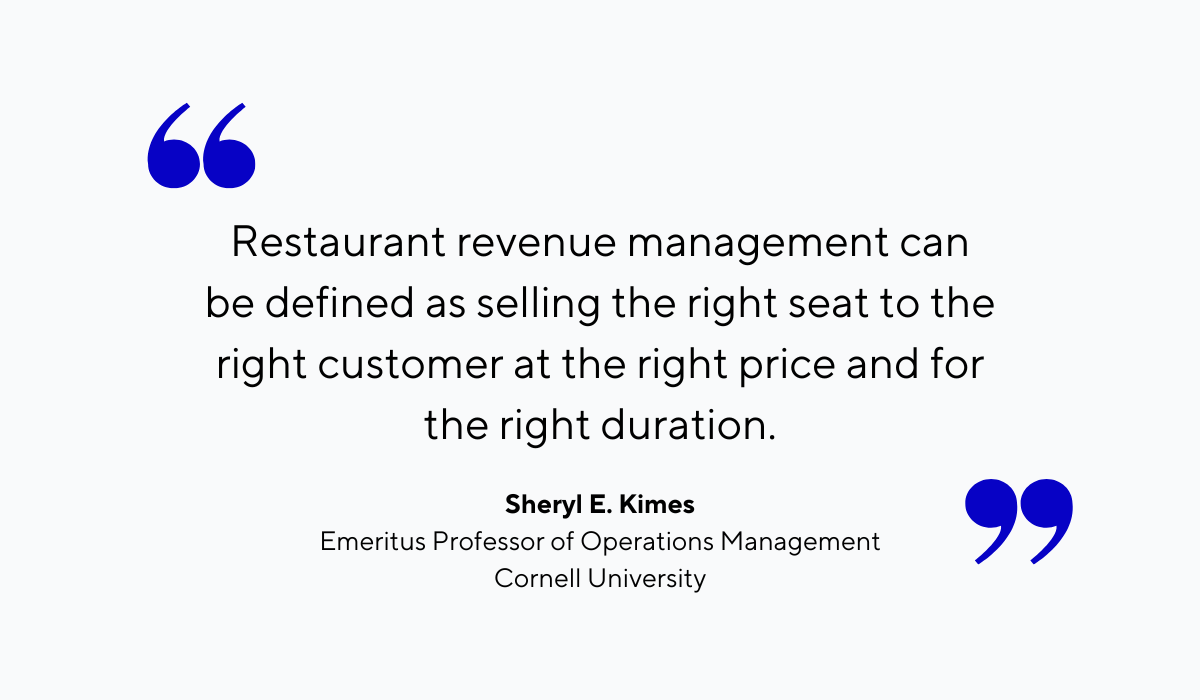 Illustration: Tablein / Quote: Gale Academic OneFile
Illustration: Tablein / Quote: Gale Academic OneFile
Therefore, we can say that efficient restaurant revenue management starts with an efficient reservation process.
Does your staff still take reservations over the phone or via email?
Are they then required to figure out where and when they can fit the patron in without taking someone else’s table and time slot?
If you said yes, it’s time to consider investing in restaurant reservation software.
Implementing a system like that into your daily operations won’t only make the task of making reservations easier for your guests—it will also positively impact your revenue by maximizing your table occupancy.
Let’s explain what we mean using our restaurant reservation software, Tablein, as an example.
Once you’ve integrated the Tablein online reservation widget into your restaurant’s website, it will take your guests just a few clicks to book a table for the desired date and time.

Source: Tablein
This means they won’t have to contact the restaurant with the preferred time slot, wait for a response, find out that there are actually no tables available in that time frame, and then end up back at square one.
Being able to book a table online is likely extremely important to your guests, and Toast’s Restaurant Success Report confirms it.
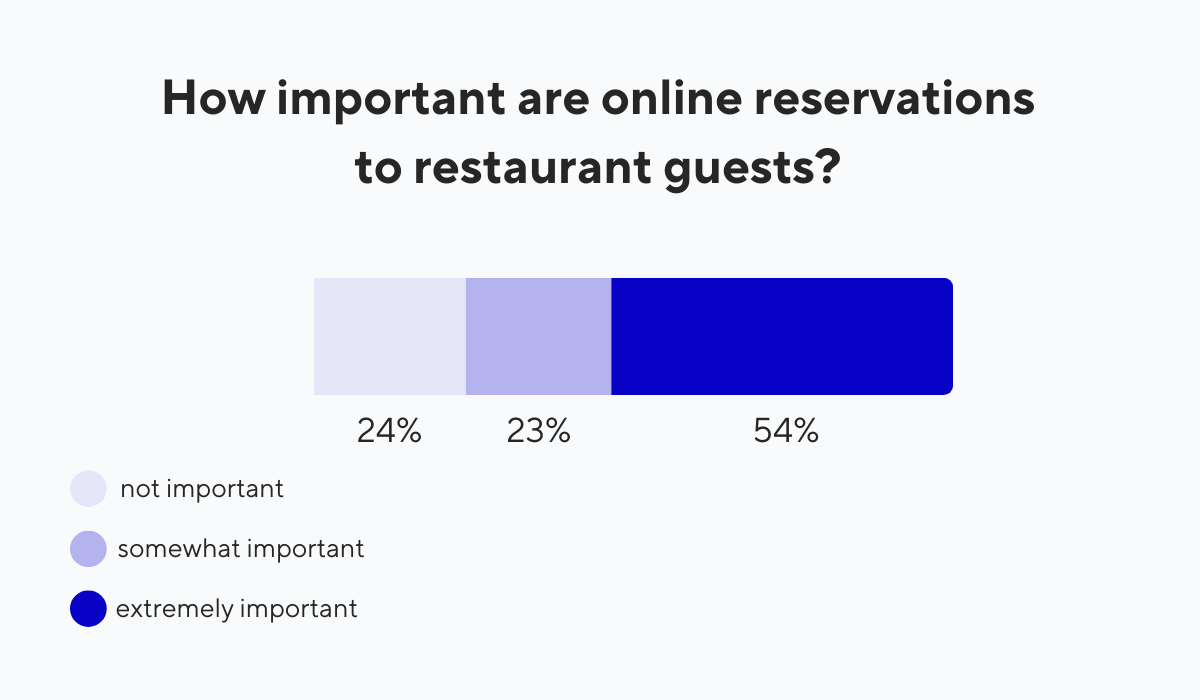
Illustration: Tablein / Data: Toast
Without an online reservation system in place, you’re bound to miss out on a large number of guests who would otherwise happily book a table and, consequently, increase your revenue.
So, take some time to reassess the way you manage reservations at your restaurant.
After all, introducing an online reservation system could be just the thing you need to take your revenue management to the next level.
Table Turnover Optimization
Making sure that your tables are full at all times is another important facet of restaurant revenue management.
But to ensure that those tables are bringing you the maximum amount of revenue, you need to employ the second strategy on our list today—table turnover optimization.
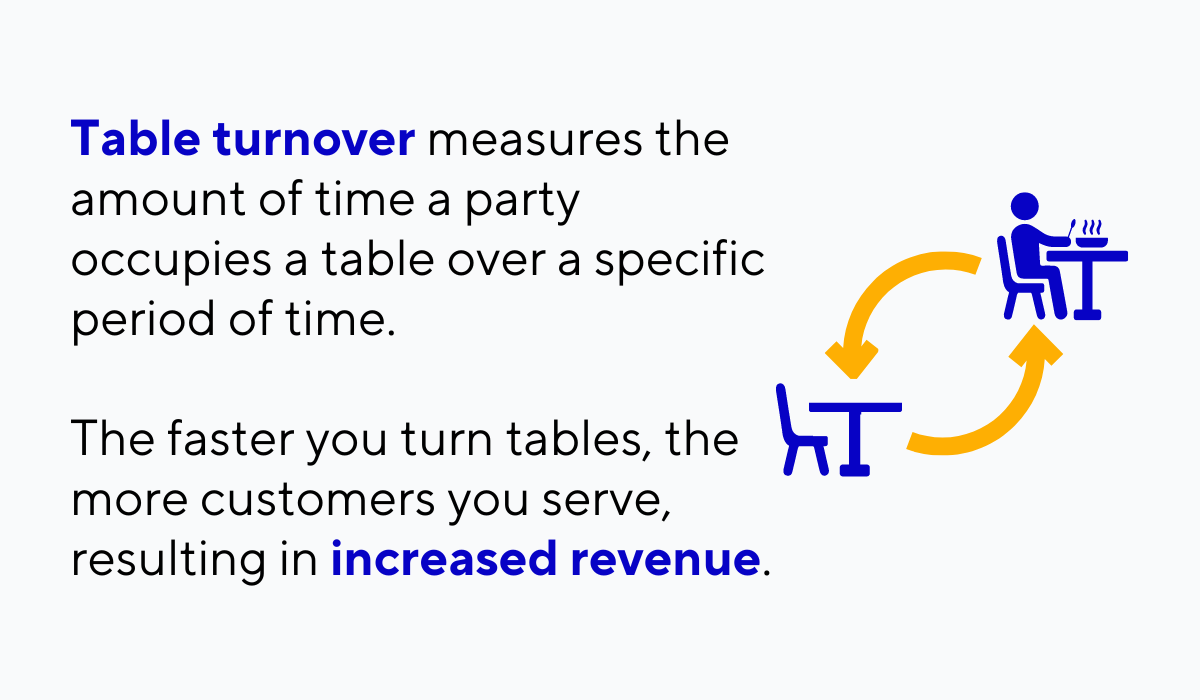
Illustration: Tablein / Data: Quandoo
To put it simply: if your goal is to increase your revenue, you need to maximize the number of guests you serve.
Introducing a table time limit is a strategy that many restaurants employ in order to achieve that.
But how do you set one without compromising the satisfaction of your guests?
The answer is: through open and timely communication, like in the example below.
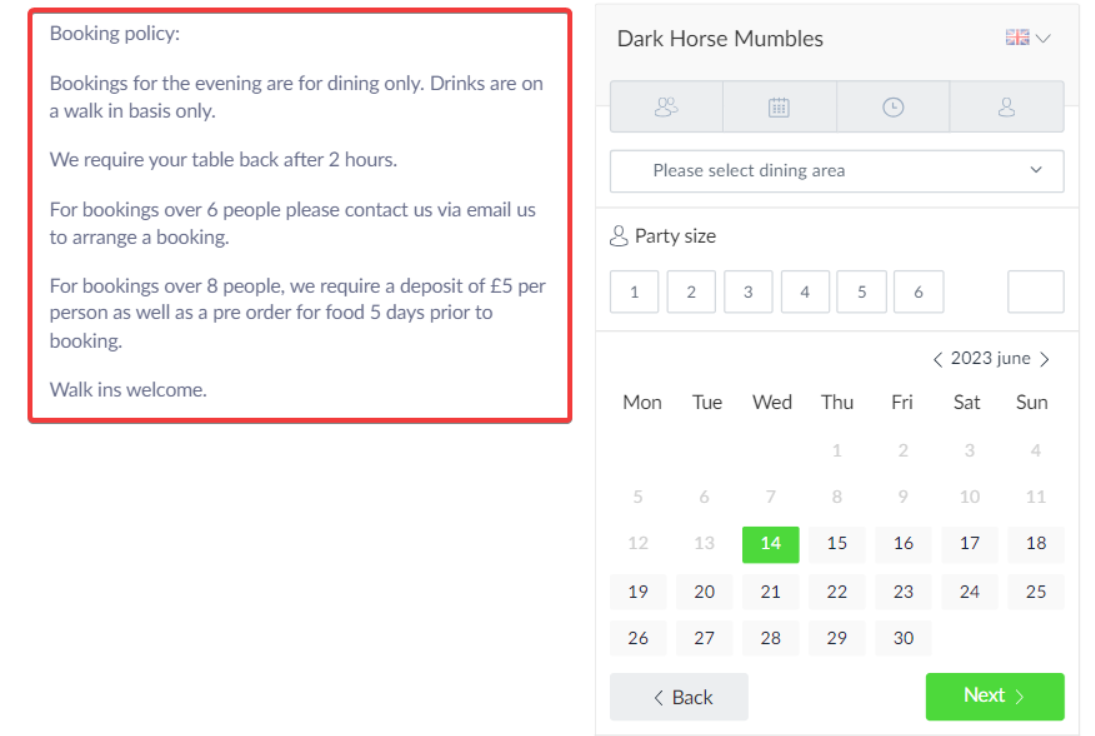
Source: Tablein
This restaurant informs its patrons about the table time limit during the table reservation process.
That way, the guests are made aware of the restaurant’s policy before they complete their reservation or pay any deposits, allowing them to decide whether they want to proceed with their reservation or not.
But this transparent approach doesn’t only set the expectations for your guests.
It also helps you plan your operations so that your patrons can finish their meals and enjoy their experience at your restaurant without feeling rushed.
This is another instance where an online table booking system is your biggest ally.
A system like that is going to give you a holistic view of all of your reservations for any given day, allowing you to adjust your staffing levels and other resources for maximum efficiency.
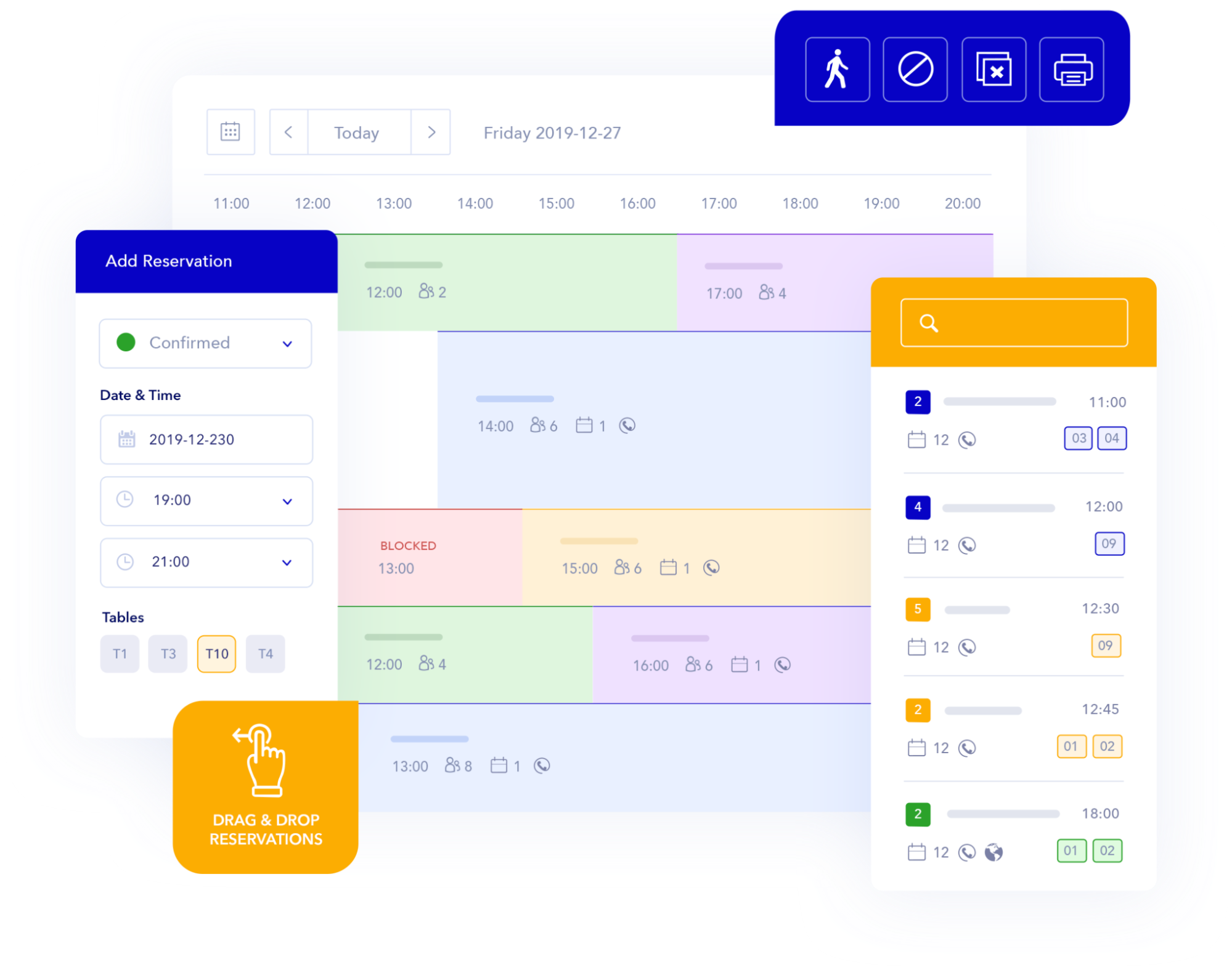
Source: Tablein
With this information at your fingertips, you and your staff can take the necessary steps to ensure that all of your guests are promptly greeted, seated, and served, giving them enough time to enjoy the meal at their own pace.
So, as you can see, maximizing your table turnover doesn’t have to be a headache.
With the right tools, you can increase your table turnover rate, maximize your revenue, and optimize your revenue management.
Demand Forecasting
When it comes to successful restaurant revenue management, wisely allocating your resources—primarily your staff and inventory—is integral.
But making sure that you’re not over- or understaffed, that your inventory levels are perfectly balanced, and that you’re successfully capitalizing on peak demand periods can be difficult.
This is where demand forecasting comes in.

Illustration: Tablein / Data: LinkedIn
In other words, you need to take a data-driven approach in order to identify when to expect an increase or a decrease in demand.
To get the historical data needed for adjusting your resource allocation and maximizing your revenue, you can turn to your reservation software.
If it has a reporting feature, it should be able to provide you with graphs and charts such as the ones below.

Source: Tablein
Finding out what your most booked hours were this time last year and going through guest feedback will uncover important information that will help you make the most of your resources.
- What days of the week and times of the day seem to be the busiest?
- What menu items do the guests praise the most in their reviews?
You can answer those questions using historical data, and then adjust your inventory and staffing levels, as well as your table availability and even menu offerings, accordingly.
Be careful, however, not to rely only on historical data.
The demand also depends on a variety of external factors, such as events, that can instantly turn an ordinary Wednesday into the busiest day at your restaurant.
Let’s say that a popular artist is performing in your city.
Knowing that your restaurant is on the way to the venue, and assuming that concert-goers will want to grab a bite beforehand, you need to prepare yourself for an increase in demand.
Let’s take a look at an example of a restaurant that did this successfully, according to their guest:

Source: Tripadvisor
As you can see, the guest chose this restaurant partially due to its proximity to the concert venue and wasn’t disappointed with the service.
And based on the restaurant’s response to this glowing review, it’s clear that they knew to anticipate increased traffic, so they prepared accordingly.

Source: Tripadvisor
This example goes to show just how important it is to stay in the know about the various external factors that can impact your demand, and how being well-prepared in terms of staff and inventory can benefit your revenue management efforts.
Menu Engineering
Now that you know how to streamline your reservation process, optimize table turnover, and better anticipate guest demand, it’s time to take a look at your menu.
Let’s face it: no amount of strategizing is going to make up for a lackluster menu, and not even the best menu is going to reach its maximum profitability without deliberate menu engineering.

Illustration: Tablein / Data: Popmenu
Once you’ve developed a menu that you’re happy with and priced it to make sure it’s profitable, it’s time to work on the design.
First, you’re going to sort your menu items based on how popular and profitable they are.
To help you with the categorization, you can use a menu engineering matrix.

Source: Tablein
Put your most popular, most profitable items into the Star category, whereas your least popular and least profitable items will be sorted into the Dog category.
Your highly profitable, but not very popular items will fall into the Puzzle category, and the lower-profit, but popular dishes are going to be your Plow Horses.
With these findings in mind, you can confidently take the next step in menu optimization: redesigning your menu to make the most of each item you offer.
Depending on the format of your menu card, your guests’ eyes will naturally shift to different areas of the menu:

Illustration: Tablein / Data: Lightspeed
With that in mind, make sure that the dishes from the Star category end up in the areas that get the most attention.
This will make your guests more likely to go for those high-profit items.
Then, take your menu engineering efforts a step further by adding appealing meal descriptions and removing the currency symbols and decimals from the prices.
According to a Cornell University study, this little tweak can do wonders for your revenue.
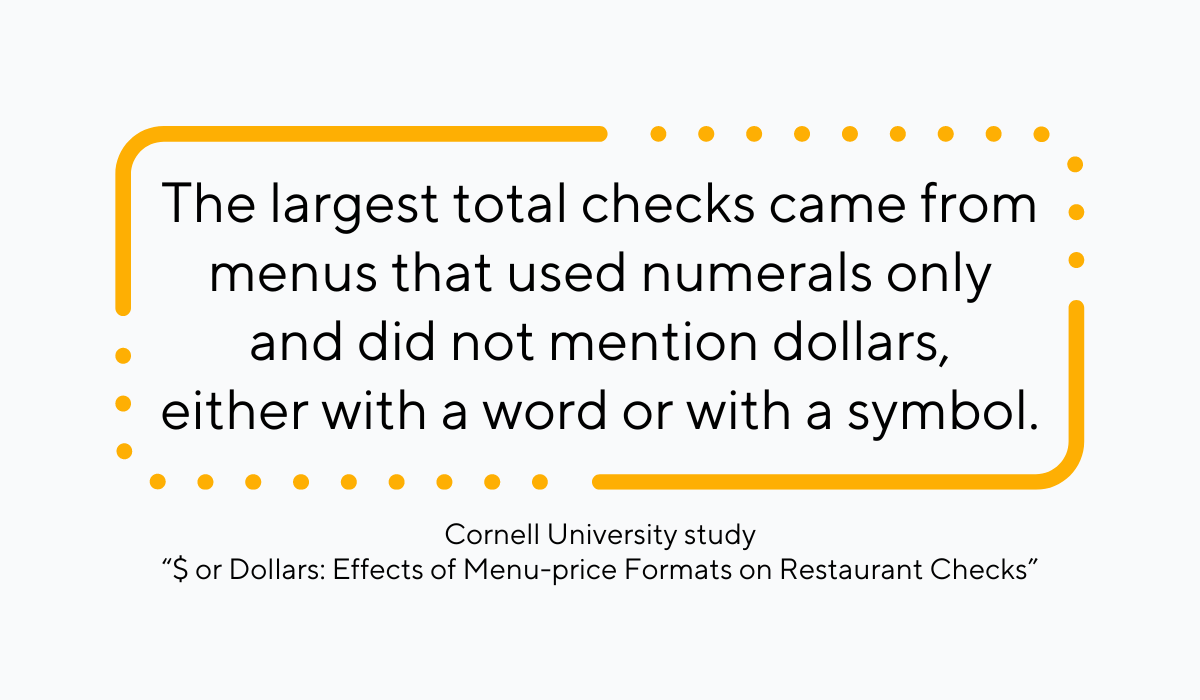
Illustration: Tablein / Data: Cornell University
As for the other three categories in your matrix—Dogs, Puzzles, and Plow Horses—they are going to require more significant adjustments.
For example, you can market Puzzles as chef’s specials. This will instantly make them appear more desirable.
To make your Plow Horses bring in more revenue, leverage their popularity to increase their price, or train your staff to recommend some of your higher-profit items to complement such dishes.
Lastly, you can consider completely removing the low-profit, unpopular dishes from your menu.
Getting rid of them will not only save you money, but also reduce the option paralysis your patrons might experience when faced with too many menu items.
We’ve also dedicated an entire article to the art of menu engineering, so we encourage you to check it out for a deep dive into this important topic.
Dynamic Pricing
Once you’ve successfully optimized your menu, it’s time to implement our final strategy for this article: dynamic pricing.
Dynamic pricing is a revenue management pricing strategy that involves adjusting menu prices depending on factors like demand, seasonality, or market competition.
This strategy is going to help your restaurant adapt to changing market conditions and keep it competitive, so it’s definitely one worth considering.
And, according to Colin Webb, the co-founder of the dynamic pricing platform Sauce, restaurants who use dynamic pricing are reaping the benefits:

Illustration: Tablein / Quote: Back of House
So, how can you introduce dynamic pricing at your own restaurant?
Well, chances are, you’re already implementing it.
Is the happy hour a thing at your restaurant? Do you offer early bird discounts to guests who dine before the dinner rush begins?
Both of these fall under the dynamic pricing category.
And while both are meant to attract more guests during off-peak times, early bird discounts are also a great way to increase table turnover and prevent overcrowding later on in the evening.
This restaurant made use of this strategy by offering an early bird dinner deal to guests who finish dining by 7.30 pm on the weekends.

Source: Kiseki on Facebook
Keep in mind, though, that dynamic pricing isn’t a one-size-fits-all.
This means you’re going to have to use your judgment to determine when increasing or decreasing prices makes the most sense for your restaurant in particular.
Let’s say your restaurant is known for serving dishes featuring fresh, seasonal ingredients.
Naturally, those ingredients will have limited availability in the off-season, making it more challenging—and more costly—for you to obtain them.
In that scenario, should a dish exist throughout the year, it would make sense for you to increase your prices accordingly, as this reflects the effort that goes into sourcing the ingredients, as well as your commitment to maintaining the highest quality standards.
On the other hand, for more data-driven insights, you can turn to the data and analytics extracted from your restaurant technology.
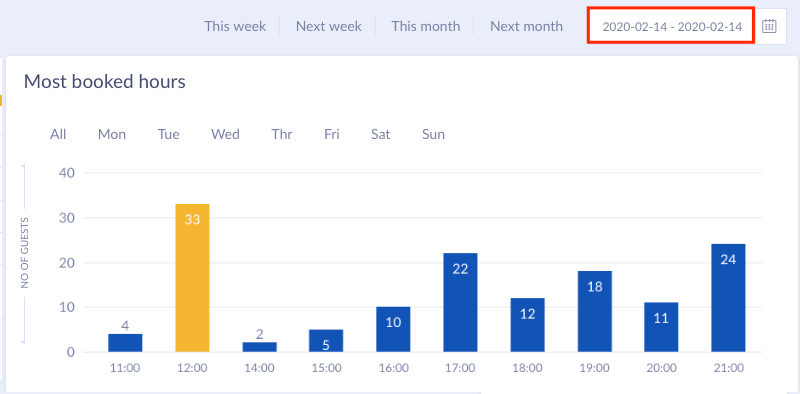
Source: Tablein
You can leverage information such as the above to incentivize your guests to visit you during off-peak hours, or increase the pricing of higher-profit items when demand is at its highest.
Whatever method you choose to implement, though, don’t forget to remain transparent with your guests and communicate the reasons behind these price adjustments.
That way, they’ll know exactly what they can expect, and you’ll be able to make the most of this lucrative strategy without backlash.
Conclusion
And with that, we wrap up our list of strategies you can apply for more effective revenue management at your restaurant.
The strategies we presented in this article are bound to help you tackle various revenue management challenges—from a cumbersome reservation process that lowers your table occupancy to a menu that doesn’t bring you as much revenue as it could.
So, give them a try and watch your restaurant thrive even in the most competitive of markets.
Get a 30-day Exclusive Trial
As a Tablein blog reader, you’re eligible for an exclusive 30-day free trial to experience our simple reservation solution for your restaurant.
Enter your business email, and we’ll send you all the steps needed to create your account.
Share this
You may also like

What You Need to Know About Restaurant Revenue Management

The Ultimate Guide to Restaurant Table Turnover
